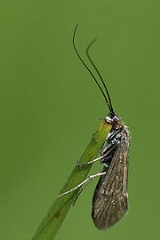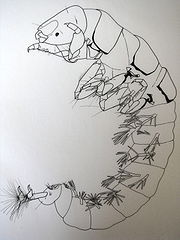
Hydropsychidae
Encyclopedia
Hydropsychidae are a family
-level taxon consisting of net-spinning caddisflies
. Hydropsychids are common among much of the world's streams and a few species occupy the shorelines of freshwater lakes. Larva
e of the hyrdopsychids construct nets at the open end of their dwellings which is responsible for their "net-spinning caddisfly" common name
.
larvae, is spent entirely in freshwater
. They construct dwellings known as "retreats", which are fixed to the sides of rocks. These retreats are typically composed of collected plant and mineral fragments. At the large open end of their retreat, hydropsychids spin a net or sieve
made of fine silk, similar to the silk produced by the larval form of the Lepidoptera
(caterpillars), one of their close relatives. These nets catch algae
, detritus
, and smaller invertebrates. Different genera
spin nets of different mesh sizes and shape depending on what food type they are targeting. Because of this technique of food collection, hydropsychids require flowing water in order to ensnare items of food into their net.

 Hydropsychids are capable of performing a defensive stridulation in their larval stages. Individuals stridulate in order to dissuade other hydropsychids from attempted to steal their retreat. When individuals abandon, or become dislodged from, their retreat, they must build or seize a new retreat. It has be shown that "home-less" hyrdopsychids will sometimes search out retreats currently occupied by another member of their species
Hydropsychids are capable of performing a defensive stridulation in their larval stages. Individuals stridulate in order to dissuade other hydropsychids from attempted to steal their retreat. When individuals abandon, or become dislodged from, their retreat, they must build or seize a new retreat. It has be shown that "home-less" hyrdopsychids will sometimes search out retreats currently occupied by another member of their species
. This can result in a confrontation between individuals, each vying for ownership of an established retreat. Stridulating warns foes that a retreat is occupied and attempting to enter is unwise. This noise is made by running their femur
across ridges on the underside of their head. It is still unclear whether this noise is also used to dissuade insect
predators.
 Hydropsychid larva
Hydropsychid larva
e are unique from most Trichoptera
n due to their fully scleritized
dorsum
. Only the Hydroptilidae
family share this characteristic with the Hydropsychids. This feature combined with branched gills running along ventral surface of the abdomen
differentiate the Hydropsychid from all other Trichopteran. The Hydropsychids have large anal proleg
s equipped with hooks allowing them to grasp the side of rocks in river and stream beds. Individuals are easily identified without the use of a lens by their large curved bodies.
. Some genera
, sensitive to certain contaminants or pollutants
, suffer declines in growth and/or survival. Thus, like a canary
in a coal mine, researchers can examine stream Hydropsychid populations to assess stream-health (see EPT or Index of Biological Integrity
).
Family (biology)
In biological classification, family is* a taxonomic rank. Other well-known ranks are life, domain, kingdom, phylum, class, order, genus, and species, with family fitting between order and genus. As for the other well-known ranks, there is the option of an immediately lower rank, indicated by the...
-level taxon consisting of net-spinning caddisflies
Trichoptera
The caddisflies are an order, Trichoptera, of insects with approximately 12,000 described species. Also called sedge-flies or rail-flies, they are small moth-like insects having two pairs of hairy membranous wings...
. Hydropsychids are common among much of the world's streams and a few species occupy the shorelines of freshwater lakes. Larva
Larva
A larva is a distinct juvenile form many animals undergo before metamorphosis into adults. Animals with indirect development such as insects, amphibians, or cnidarians typically have a larval phase of their life cycle...
e of the hyrdopsychids construct nets at the open end of their dwellings which is responsible for their "net-spinning caddisfly" common name
Common name
A common name of a taxon or organism is a name in general use within a community; it is often contrasted with the scientific name for the same organism...
.
Larvae
The hydropsychid larval life-stage, like most TrichopteraTrichoptera
The caddisflies are an order, Trichoptera, of insects with approximately 12,000 described species. Also called sedge-flies or rail-flies, they are small moth-like insects having two pairs of hairy membranous wings...
larvae, is spent entirely in freshwater
Freshwater
Fresh water is naturally occurring water on the Earth's surface in ice sheets, ice caps, glaciers, bogs, ponds, lakes, rivers and streams, and underground as groundwater in aquifers and underground streams. Fresh water is generally characterized by having low concentrations of dissolved salts and...
. They construct dwellings known as "retreats", which are fixed to the sides of rocks. These retreats are typically composed of collected plant and mineral fragments. At the large open end of their retreat, hydropsychids spin a net or sieve
Sieve
A sieve, or sifter, separates wanted elements from unwanted material using a woven screen such as a mesh or net. However, in cooking, especially with flour, a sifter is used to aerate the substance, among other things. A strainer is a type of sieve typically used to separate a solid from a liquid...
made of fine silk, similar to the silk produced by the larval form of the Lepidoptera
Lepidoptera
Lepidoptera is a large order of insects that includes moths and butterflies . It is one of the most widespread and widely recognizable insect orders in the world, encompassing moths and the three superfamilies of butterflies, skipper butterflies, and moth-butterflies...
(caterpillars), one of their close relatives. These nets catch algae
Algae
Algae are a large and diverse group of simple, typically autotrophic organisms, ranging from unicellular to multicellular forms, such as the giant kelps that grow to 65 meters in length. They are photosynthetic like plants, and "simple" because their tissues are not organized into the many...
, detritus
Detritus
Detritus is a biological term used to describe dead or waste organic material.Detritus may also refer to:* Detritus , a geological term used to describe the particles of rock produced by weathering...
, and smaller invertebrates. Different genera
Genus
In biology, a genus is a low-level taxonomic rank used in the biological classification of living and fossil organisms, which is an example of definition by genus and differentia...
spin nets of different mesh sizes and shape depending on what food type they are targeting. Because of this technique of food collection, hydropsychids require flowing water in order to ensnare items of food into their net.


Species
In biology, a species is one of the basic units of biological classification and a taxonomic rank. A species is often defined as a group of organisms capable of interbreeding and producing fertile offspring. While in many cases this definition is adequate, more precise or differing measures are...
. This can result in a confrontation between individuals, each vying for ownership of an established retreat. Stridulating warns foes that a retreat is occupied and attempting to enter is unwise. This noise is made by running their femur
Arthropod leg
The arthropod leg is a form of jointed appendage of arthropods, usually used for walking. Many of the terms used for arthropod leg segments are of Latin origin, and may be confused with terms for bones: coxa , trochanter , femur, tibia, tarsus, ischium, metatarsus, carpus, dactylus ,...
across ridges on the underside of their head. It is still unclear whether this noise is also used to dissuade insect
Insect
Insects are a class of living creatures within the arthropods that have a chitinous exoskeleton, a three-part body , three pairs of jointed legs, compound eyes, and two antennae...
predators.
Anatomy

Larva
A larva is a distinct juvenile form many animals undergo before metamorphosis into adults. Animals with indirect development such as insects, amphibians, or cnidarians typically have a larval phase of their life cycle...
e are unique from most Trichoptera
Trichoptera
The caddisflies are an order, Trichoptera, of insects with approximately 12,000 described species. Also called sedge-flies or rail-flies, they are small moth-like insects having two pairs of hairy membranous wings...
n due to their fully scleritized
Sclerite
A sclerite is a hardened body part. The term is used in various branches of biology for various structures including hardened portions of sponges, but it is most commonly used for the hardened portions of arthropod exoskeletons....
dorsum
Dorsum (biology)
In anatomy, the dorsum is the upper side of animals that typically run, fly, or swim in a horizontal position, and the back side of animals that walk upright. In vertebrates the dorsum contains the backbone. The term dorsal refers to anatomical structures that are either situated toward or grow...
. Only the Hydroptilidae
Hydroptilidae
Hydroptilidae is a large family of caddisflies with a worldwide distribution. They are commonly known as microcaddisflies or purse-case caddisflies, in reference to two characteristic traits of this family: Hydroptilidae are much smaller than other caddisflies, rarely exceeding in length...
family share this characteristic with the Hydropsychids. This feature combined with branched gills running along ventral surface of the abdomen
Abdomen
In vertebrates such as mammals the abdomen constitutes the part of the body between the thorax and pelvis. The region enclosed by the abdomen is termed the abdominal cavity...
differentiate the Hydropsychid from all other Trichopteran. The Hydropsychids have large anal proleg
Proleg
A Proleg is the small fleshy, stub structure found on the ventral surface of the abdomen of most larval forms of insects of the order Lepidoptera, though they can also be found on other larval insects such as sawflies and a few types of flies....
s equipped with hooks allowing them to grasp the side of rocks in river and stream beds. Individuals are easily identified without the use of a lens by their large curved bodies.
Environmental Indicators
Due to Hydropsychid's presence in a wide range of rivers and streams world wide, it has been favored as a indicator speciesIndicator species
An indicator species is any biological species that defines a trait or characteristic of the environment. For example, a species may delineate an ecoregion or indicate an environmental condition such as a disease outbreak, pollution, species competition or climate change...
. Some genera
Genera
Genera is a commercial operating system and development environment for Lisp machines developed by Symbolics. It is essentially a fork of an earlier operating system originating on the MIT AI Lab's Lisp machines which Symbolics had used in common with LMI and Texas Instruments...
, sensitive to certain contaminants or pollutants
Pollution
Pollution is the introduction of contaminants into a natural environment that causes instability, disorder, harm or discomfort to the ecosystem i.e. physical systems or living organisms. Pollution can take the form of chemical substances or energy, such as noise, heat or light...
, suffer declines in growth and/or survival. Thus, like a canary
Domestic Canary
The Domestic Canary, often simply known as the canary, is a domesticated form of the wild Canary, a small songbird in the finch family originating from the Macaronesian Islands ....
in a coal mine, researchers can examine stream Hydropsychid populations to assess stream-health (see EPT or Index of Biological Integrity
Index of biological integrity
An Index of Biological Integrity , also called an Index of Biotic Integrity, is a scientific tool used to identify and classify water pollution problems...
).

